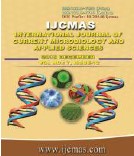


 National Academy of Agricultural Sciences (NAAS)
National Academy of Agricultural Sciences (NAAS)

|
PRINT ISSN : 2319-7692
Online ISSN : 2319-7706 Issues : 12 per year Publisher : Excellent Publishers Email : editorijcmas@gmail.com / submit@ijcmas.com Editor-in-chief: Dr.M.Prakash Index Copernicus ICV 2018: 95.39 NAAS RATING 2020: 5.38 |
2,3-Butanediol (2,3-BD) is one of the promising bulk chemicals due to its extensive industrial application. We need to exploit the innate potential of its microbial producers which also possess delignification and saccharification abilities to facilitate the use of renewable and cheaper agro-residues as raw materials for fermentation. Strains of Lactic acid bacteria, Paenibacillus and Clostridium were tested for production of 2,3-BD by high through put determination of a pathway intermediate acetoin by Vogues Proskauer test. The VP positive isolates were grown as shaken flask cultures and the concentration of the accumulated 2,3 BD was determined by Gas chromatography. The highest amount of 18.577 g 2,3 BD /L was produced by the LAB isolate LDL-18, followed by other LAB isolates LA-3 and LGr-5 which produced 1.3908 and 1.9893 g/L of 2,3-BD respectively. Both the Panebacillus strains showed very less production of 2, 3 BD. Further the possibility of producing 2,3-BDL was tested by using agro-residues viz., pineapple pulp waste and delignified paddy straw at different concentrations in batch fermentation. This study is a prelude to an alternate, sustainable energy management strategy to fulfil the increasing demand of this useful chemical and to overcome its expensive chemical synthesis.
 |
 |
 |
 |
 |